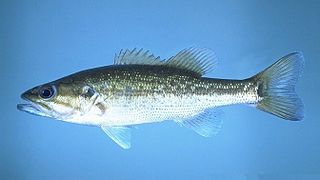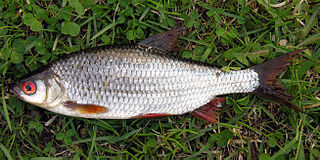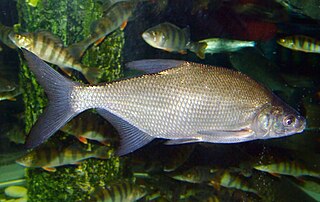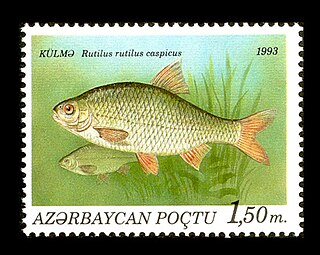
The spotted bass, also called spotty, or spots in various fishing communities, is a species of North American freshwater fish belonging to the sunfish family (Centrarchidae) of the order Perciformes. It is noted for the rows of dark spots below the lateral line, which give it its common name. One of the black basses, it is native to the Mississippi River basin and across the Gulf states, from central Texas through the Florida panhandle. Its native range extends into the western Mid-Atlantic states and it has been introduced into western North Carolina and Virginia. It has also been introduced to southern Africa, where it has become established in some isolated waters as an invasive species.

The ide, or orfe, is a freshwater fish of the family Cyprinidae found in larger rivers, ponds, and lakes across Northern Europe and Asia. It has been introduced outside its native range into Europe, North America, and New Zealand. It is a popular ornamental fish, usually kept in outdoor ponds in temperate regions from which it often escapes.

The bluegill, sometimes referred to as "bream", "brim", "sunny", or, as is common in Texas, "copper nose", is a species of North American freshwater fish, native to and commonly found in streams, rivers, lakes, ponds and wetlands east of the Rocky Mountains. It is the type species of the genus Lepomis, from the family Centrarchidae in the order Perciformes.

The grass carp is a species of large herbivorous freshwater fish in the family Cyprinidae, native to the Pacific Far East, with a native range stretching from northern Vietnam to the Amur River on the Sino-Russian border. This Asian carp is the only species of the genus Ctenopharyngodon.

The sailfin molly is a livebearer fish typically found in both freshwater and brackish waterways along the East Coast of the United States, from North Carolina south to Florida, and around the Gulf of Mexico to Texas, and south to the Yucatán Peninsula of México. Given their preference for more brackish water conditions, mollies are often found within just a few yards or miles of the ocean, inhabiting coastal estuaries, lagoons, river deltas and swamps, as well as tidal areas with a regular inflow of oceanic minerals and nutrients mixing with inland freshwater sources.

The pumpkinseed, also referred to as pond perch, common sunfish, punkie, sunfish, sunny, and kivver, is a small/medium-sized North American freshwater fish of the genus Lepomis, from family Centrarchidae in the order Perciformes.
The classification of European rivers comes from the fish fauna found in them. Changes in taxonomic composition relate to physical and chemical changes that occur longitudinally.

The roach, or rutilus roach, also known as the common roach, is a fresh- and brackish-water fish of the family Cyprinidae, native to most of Europe and western Asia. Fish called roach can be any species of the genera Rutilus, Leucos and Hesperoleucus, depending on locality. The plural of the term is also roach.

The common bleak is a small freshwater coarse fish of the cyprinid family.

The common bream, also known as the freshwater bream, bream, bronze bream, carp bream or sweaty bream, is a European species of freshwater fish in the family Cyprinidae. It is now considered to be the only species in the genus Abramis.

The New Zealand smelt, also known as the New Zealand common smelt, New Zealand cucumber fish, or silveries is a smelt of the family Retropinnidae, found only in New Zealand at shallow depths in estuaries and rivers. Their length is between 8 and 13 cm.

The golden shiner is a cyprinid fish native to eastern North America. It is the sole member of its genus. Much used as a bait fish, it is probably the most widely pond-cultured fish in the United States. It can be found in Quebec, and its French name is "Mené jaune" or "Chatte de l'Est".

The Fen of Lans is located north above Lake Lans at an altitude of 582 metres in the Paschberg forest. With an area of 8000 m² and a depth of 3 metres the lake is much smaller than its neighbour.

The southern redbelly dace, is a North American species of temperate freshwater fish of the family Cyprinidae. The natural geographic range extends from Western New York to Minnesota, and south to Oklahoma, Arkansas, and Alabama. This fish prefers flowing pools of creeks and streams.

Scardinius is a genus of ray-finned fish in the family Cyprinidae commonly called rudds. Locally, the name "rudd" without any further qualifiers is also used for individual species, particularly the common rudd. The rudd can be distinguished from the very similar roach by way of the rudd's upturned mouth, allowing it to pick food items such as aquatic insects from the surface of the water with minimal disturbance.

The eastern mudminnow is a species of freshwater fish belonging to the family Umbridae. It is native to eastern North America, but has been introduced to Europe. It feeds primarily on insect larvae and other small aquatic invertebrates.

Goggausee is a lake of Carinthia, Austria.The Goggausee lies in the area of the Gurktaler Alps, north of Feldkirchen in Carinthia, in a very windless pool. Due to the sheltered location, the water is not mixed well and is oxygen‐poor after a few metres.

The chameleon goby is a species of ray-finned fish native to marine and brackish waters along the coasts of eastern Asia. It has also spread to other parts of the world where it is found in waters with varying degrees of salinity.

The scarlet shiner is a freshwater fish native to the eastern United States.

The Caspian roach is a species of roach fish living in the Caspian Sea. The Caspian roach can be distinguished from other roaches by its laterally compressed body, silvery grey iris, rounded snout and grey pectoral pelvic and anal fins with dark margins. The Caspian roach is semi-anadromous and inhabits mostly shallow coastal waters. It enters Volga, Ural, Emba, Terek and Kura drainages for spawning.





















